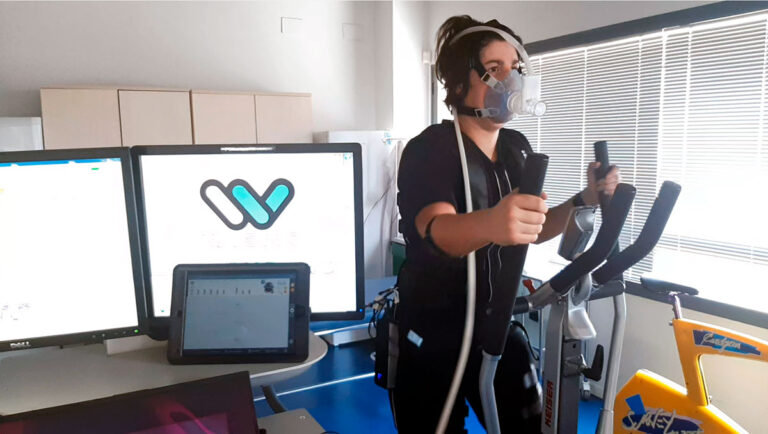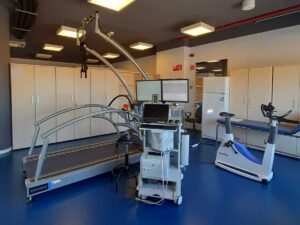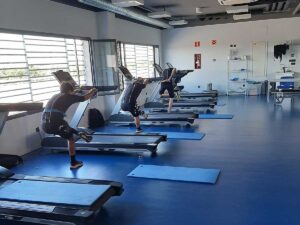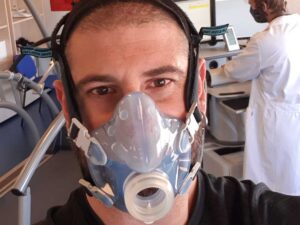Full body global electrostimulation (WB-EMS) is a solution widely used in the fitness sector to enhance the results of a workout.
This system works thanks to electrodes strategically placed in those main muscle groups. An electrical current or electrical impulse travels through these electrodes. This impulse penetrates the deepest muscle fibers, favoring a more powerful and effective muscle contraction. This muscle contraction is ideal for strengthening the muscle and its results, without injuring it and without having to lift heavy loads as would happen in conventional training.
Does Electrostimulation cause a greater increase in Heart Rate?
This fact causes an increase in heart rate (HR) just like any other type of voluntary physical exercise. However, we are unaware of the relationship between certain electrical parameters and the elevation of heart rate at rest and during exercise.
In today’s study we are going to analyze the project developed at the Wiems Lab in which we wanted to check what derivation occurs in the heart rate when we apply electrostimulation with two different frequencies (7 Hz and 21 Hz) during a low intensity aerobic training in elliptical.
The electrifitty project
In the Electrifitty project we carry out a training based on aerobic exercise on the elliptical and on a stationary bike. Our objective was to verify the added effect of electrostimulation (EMS) during a 4-week intervention on body composition and muscle strength. However, this time we want to analyze what response exists in a single session.
We are aware that WB-EMS is a good tool to raise heart rate per se. In fact, we have been able to verify that it not only increases heart rate, but also has an effect on energy expenditure and on the oxidation of substrates. However, we have not quantified how much the heart rate rises and, above all, if it depends on the frequency and intensity used.
The data obtained will help us to be able to recommend both to trainers and trainees which EMS programs are most suitable for each objective.
In previous Wiems Lab studies we have already carried out a sweep of the low frequencies of 1 Hz, 2 Hz, 4 Hz, 6 Hz, 8 Hz, 10 Hz, and their impact on resting energy metabolism. However, this time we are going to analyze its effect during exercise and with frequencies of 7 Hz and 21 Hz at 3 different intensities: 5/10, 7/10 and 8/10.
Initial study evaluation
As in previous evaluations, we will previously measure baseline body composition with a scale, a stadiometer (model 799, electronic Spine Scale, Hamburg, Germany), and with a dual X-ray absorptiometer scanner (Discovery Wi, Hologic, Inc. , Bedford, MA, USA). The DXA analysis is the Gold Standard (one of the best machines) for measuring bone mineral density, although it also offers information on the distribution of fat and muscle.
“We wanted to see what happened to the heart rate during low-intensity exercise and Wiemspro electrostimulation.”
This study had a cross-sectional methodology. Unlike the previous studies carried out, a cross-sectional study aims to “take a picture of a moment”, that is, to see what happens at a specific moment. In this sense, we wanted to see what happened with the heart rate during low-intensity exercise and with the Wiemspro electrostimulation placed at 2 different frequencies. In the same way as in intervention studies, a series of descriptive data of the population is taken to later be able to draw conclusions.
Participant Profile
For this study we had a total of 9 adult males with a mean age of 24 ± 3 years. Some of them had previous experience in electrostimulation training, and others did not. The following table shows the descriptive data of this population:
| Table 1. Descriptive characteristics of the study participants. | All (n=9) |
|---|---|
| Age (years) | 24 (3) |
| Weight (kg) | 66.78 (13.50) |
| Height (m) | 1.7 (0.07) |
| IMC (kg/m2) | 23.01 (3.33) |
| Waist circumference (cm) | 76.89 (7.90) |
| Hip circumference (cm) | 93.85 (8.66) |
| waist-hip ratio | 0.82 (0.04) |
| T Score óseo | 0.95 (0.49) |
| Z Score óseo | 1.00 (0.42) |
| Muscle mass (kg) | 47.1 (7.7) |
| Fat-free mass (kg) | 49.5 (8.1) |
| Fat mass (kg) | 16.5 (7.1) |
| Fat mass (%) | 24 (6) |
| Visceral adipose tissue mass (kg) | 288 (122) |
| Volume of visceral adipose tissue (kg/m2) | 312 (132) |
| Visceral adipose tissue area (cm2) | 60 (25) |
We are faced with an apparently healthy and sporty population:
- Regarding the BMI, we can highlight that values of 23.01 3.33 are adequate for normal weight-low overweight.
- On the other hand, both waist and hip circumferences are within normal values.
- Also, the T-Score (how much higher or lower your bone density is) and Z-Score are pretty good at demonstrating good bone health.
- Muscle mass and fat mass are well distributed and visceral adipose tissue does not appear to be high.
Intervention protocol
As we have previously anticipated, this time the study was cross-sectional. In order to analyze how the heart rate rose in response to a certain stimulus with electrostimulation, we asked all the participants to come in the same conditions on the day of the test (It is very important that this structure be followed very carefully, since results depend on it).
The conditions to be replicated for all the participants had to do with the conditions of arrival at the laboratory, the time of the previous meal, the physical exercise and the food itself. Thus, we ask all participants to comply with the following conditions:
- Perform a 4-hour fast.
- Do not exercise vigorously or moderately the day before the test.
- Make the meal standardized by the group.
Since one of our questions is to analyze how the oxidation of substrates is modified during exercise with electrostimulation, it is very important that the hours of fasting and the pre-established meal are complied with.
Once all the preconditions were passed, we had to explain the test to all the participants. In this sense, the test was structured as follows:
Target heart rate calculation
The external intensity of the exercise was set with the goal that the participants exercised between 60 and 65% of the theoretical maximum heart rate. Each participant had an intensity appropriate to her age and her state of physical condition. However, since the mean age of our participants was 24 years and the calculation did not vary much, it was done as follows: 220- mean age = 196. 60% = 118 65% = 128. Therefore, practically all of our participants had an average heart rate during exercise of 120-125 beats per minute.
Calculation of the intensity of the elliptical
Once the target heart rate was known, we adjusted both the intensity of the elliptical (measured by level from 1 to 20) and the revolutions per minute (set between 70-80 for all participants). We conducted a short 5-minute test to verify that the intensity selected for each participant resulted in the preset target heart rate.
Test development
Because we wanted to analyze the response to two different frequencies, the order of application was randomized so that the results were not dependent on the order. Thus, some participants first had 7 Hz while others had 21 Hz. The structure of the test was as follows:
- 5 minutes to reach target HR
- 5 minute break
- 5 minutes to reach target HR
- 15 minutes of WB-EMS with the 1st frequency:
- 5 minutes at an intensity of 5/10
- 5 minutes at an intensity of 7/10
- 5 minutes at an intensity of 8/10
- 5 minute break
- 5 minutes to reach target HR
- 15 minutes of WB-EMS with the 2nd frequency:
- 5 minutes at an intensity of 5/10
- 5 minutes at an intensity of 7/10
- 5 minutes at an intensity of 8/10
- 5 minute break
The entire session was recorded using an OH 1 heart rate monitor and was connected to a gas analyzer at all times to determine energy expenditure and substrate oxidation.
What does electrostimulation contribute to this process?
This is precisely the answer we seek in this research. We already know that electrostimulation involves a greater muscular contraction of certain muscles and, consequently, an increase in oxygen consumption. However, we do not know how many extra kcal are consumed with electrostimulation, and we do not know if there are differences with the different electrical frequencies.
Electrostimulation is capable of raising the heart rate to unimaginable thresholds, as we saw in the post on low frequency at rest, but we must be very clear about what frequency to use, why to use it, when to use it and how to use it depending on the objective that we set ourselves. , and we want to solve those doubts.
Conclusion
This research carried out at the Wiems Lab has sought to further investigate the physiological bases related to whole body electrostimulation or WB-EMS (Whole Body Electrostimulation). We want to offer direct results of a certain population, and provide tools that help to better understand and apply electrostimulation.
As a summary, this study will allow us to define which are the frequencies that favor a greater increase in heart rate, and which are also related to a good state of comfort for the participant.
After this small analysis, we can conclude that electrostimulation is a tool that, on the one hand, is liked by young people, since many of them have had a good experience and, on the other hand, that WB-EMS or full body electrostimulation, It is an effective tool for increasing heart rate during low intensity exercise.
The question we should ask ourselves now is: Can the increase produced by electrostimulation make my cardiovascular fitness and my physical condition improve?
From Wiems Laboratory we will continue studying if this can be true.
Unai Adrian Perez de Arrilucea
Wiems Lab Team







